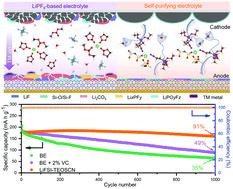当前位置:
X-MOL 学术
›
Energy Environ. Sci.
›
论文详情
Our official English website, www.x-mol.net, welcomes your
feedback! (Note: you will need to create a separate account there.)
A self-purifying electrolyte enables high energy Li ion batteries
Energy & Environmental Science ( IF 32.4 ) Pub Date : 2022-05-15 , DOI: 10.1039/d2ee00483f Di Lu 1 , Xincheng Lei 2 , Suting Weng 2 , Ruhong Li 1 , Jiedong Li 3 , Ling Lv 1 , Haikuo Zhang 1 , Yiqiang Huang 1 , Junbo Zhang 1 , Shuoqing Zhang 1 , Liwu Fan 4 , Xuefeng Wang 2 , Lixin Chen 1, 5 , Guanglei Cui 3 , Dong Su 2 , Xiulin Fan 1
Energy & Environmental Science ( IF 32.4 ) Pub Date : 2022-05-15 , DOI: 10.1039/d2ee00483f Di Lu 1 , Xincheng Lei 2 , Suting Weng 2 , Ruhong Li 1 , Jiedong Li 3 , Ling Lv 1 , Haikuo Zhang 1 , Yiqiang Huang 1 , Junbo Zhang 1 , Shuoqing Zhang 1 , Liwu Fan 4 , Xuefeng Wang 2 , Lixin Chen 1, 5 , Guanglei Cui 3 , Dong Su 2 , Xiulin Fan 1
Affiliation

|
Conventional LiPF6/carbonate electrolytes with poor oxidative stability and reactive decomposition products (HF, PF5, POF3, etc.) dictate less-stable electrode/electrolyte interphases, which thereby promote the dissolution of transition metal ions, accelerate the constant decomposition of electrolyte solvent, and result in the degradation of LIBs. Herein, we demonstrate a new type of electrolyte, id est, 1.6 M lithium bis(fluorosulfonyl)imide (LiFSI) in (2-cyanoethyl)triethoxysilane (TEOSCN) with a self-purifying feature. TEOSCN molecules in the electrolyte can effectively eliminate the reactive pernicious species, while the anions of FSI− dominate the interphase components with low-resistance on both graphite and Ni-rich NMC cathode although at an essentially low concentration. This self-purifying electrolyte system enables long-term cycling of MCMB‖NMC811 full-cells for 1000 cycles with an ultra-high capacity retention of 91% at 25 °C and for 500 cycles with a retention of 81% at 60 °C. Even in extreme cases, i.e., exposed in the air for 1 h, this electrolyte still allows the stable charge–discharge cycling of MCMB‖NMC811 full-cells without degradation, which can largely simplify the manufacturing processes of LIBs. The ‘self-purifying-plus-passivation’ strategy opens a promising frontier for electrolyte engineering towards next-generation high-energy LIBs.
中文翻译:

自净化电解质可实现高能锂离子电池
传统的 LiPF 6 /碳酸盐电解质具有较差的氧化稳定性和反应性分解产物(HF、PF 5、POF 3等),导致电极/电解质界面不稳定,从而促进过渡金属离子的溶解,加速了电解质的不断分解。电解质溶剂,并导致LIBs的降解。在此,我们展示了一种新型电解质,id est,1.6 M 双(氟磺酰基)亚胺锂(LiFSI)在(2-氰乙基)三乙氧基硅烷(TEOSCN)中具有自净化功能。电解液中的 TEOSCN 分子可以有效消除活性有害物质,而 FSI 的阴离子-在石墨和富镍 NMC 阴极上以低电阻占主导地位,尽管浓度基本上很低。这种自净化电解液系统能够实现 MCMB‖NMC811 全电池的长期循环,1000 次循环在 25 ℃下具有 91% 的超高容量保持率,在 60 ℃下实现 500 次循环并保持 81% 的超高容量。即使在极端情况下,即暴露在空气中 1 小时,这种电解液仍然可以实现 MCMB‖NMC811 全电池的稳定充放电循环而不会降解,这可以大大简化 LIB 的制造工艺。“自净化加钝化”策略为电解质工程向下一代高能锂离子电池开辟了一个充满希望的前沿。
更新日期:2022-05-15
中文翻译:

自净化电解质可实现高能锂离子电池
传统的 LiPF 6 /碳酸盐电解质具有较差的氧化稳定性和反应性分解产物(HF、PF 5、POF 3等),导致电极/电解质界面不稳定,从而促进过渡金属离子的溶解,加速了电解质的不断分解。电解质溶剂,并导致LIBs的降解。在此,我们展示了一种新型电解质,id est,1.6 M 双(氟磺酰基)亚胺锂(LiFSI)在(2-氰乙基)三乙氧基硅烷(TEOSCN)中具有自净化功能。电解液中的 TEOSCN 分子可以有效消除活性有害物质,而 FSI 的阴离子-在石墨和富镍 NMC 阴极上以低电阻占主导地位,尽管浓度基本上很低。这种自净化电解液系统能够实现 MCMB‖NMC811 全电池的长期循环,1000 次循环在 25 ℃下具有 91% 的超高容量保持率,在 60 ℃下实现 500 次循环并保持 81% 的超高容量。即使在极端情况下,即暴露在空气中 1 小时,这种电解液仍然可以实现 MCMB‖NMC811 全电池的稳定充放电循环而不会降解,这可以大大简化 LIB 的制造工艺。“自净化加钝化”策略为电解质工程向下一代高能锂离子电池开辟了一个充满希望的前沿。











































 京公网安备 11010802027423号
京公网安备 11010802027423号